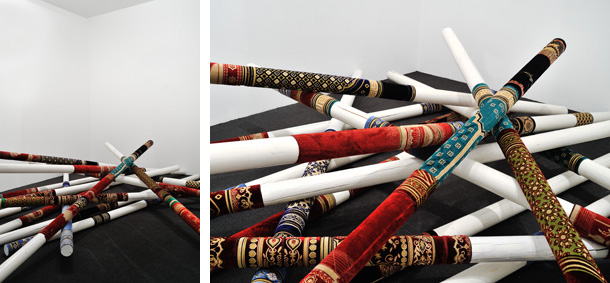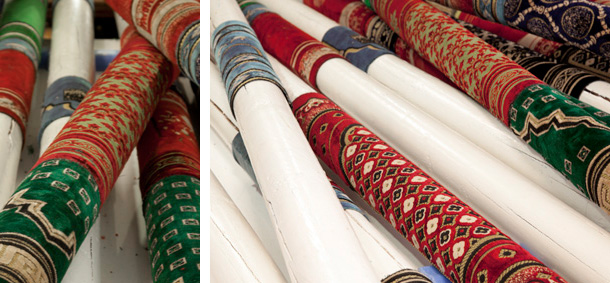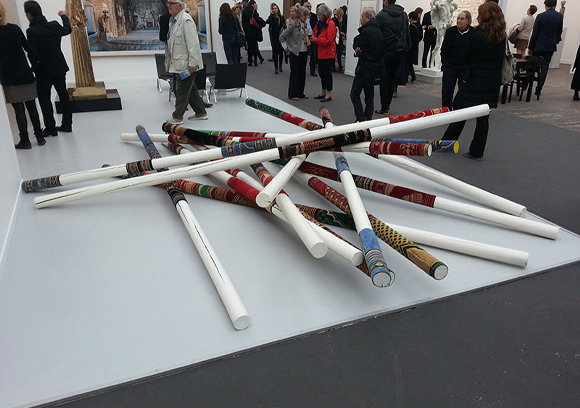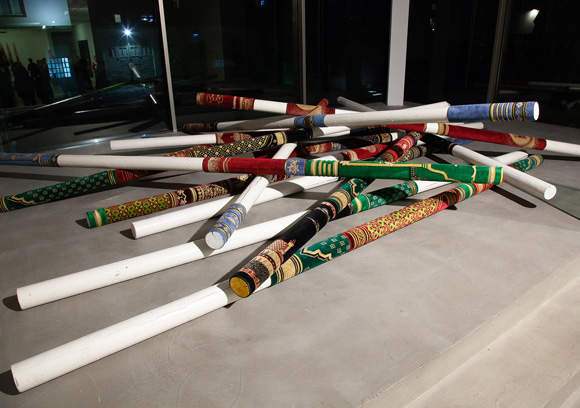| |
|
|
48.
| Motherland 01 |
| |


2013, 14 jumping poles of 4 meters, prayer rugs.
Courtesy of the artist and Ceysson & Bénétière, Paris.
Ed. of 1 + 1 A.P.

2013, 14 jumping poles of 4 meters, prayer rugs.
Courtesy of the artist and Ceysson & Bénétière, Paris.
Ed. of 1 + 1 A.P.
The installation is presented on the ground in organized chaos, showing an undeniable fall.
The beauty of the obstacle cannot mask the violence of the accident.
Studio Fatmi, May 2013

Motherland 01
Exhibition view from Art Basel Miami Beach, Galerie Yvon Lambert, 2013, Miami.
Courtesy of the artist and Ceysson & Bénétière, Paris.

Motherland 01
Exhibition view from Art Basel Miami Beach, Galerie Yvon Lambert, 2013, Miami.
Courtesy of the artist and Ceysson & Bénétière, Paris.

Motherland 01
Exhibition view from FIAC, Galerie Yvon Lambert, 2014, Paris.
Courtesy of the artist and Ceysson & Bénétière, Paris.

Motherland 01
Exhibition view from Motherland in Art, MOCAK, 2018, Krakow.
Courtesy of the artist and Ceysson & Bénétière, Paris.
|
|
|
|
|
|
Motherland est une installation constituée de 14 barres d’obstacles équestres et de tapis de prière musulmane.
Ces deux éléments font partie du vocabulaire formel de mounir Fatmi, qui les assemble ici pour la première fois.
L’ambigüité de ce travail réside dans cette dichotomie entre la beauté du tapis de prière et la violence de la chute de l’obstacle. Cette utilisation du tapis de prière comme matériel esthétique fonctionne plutôt comme un piège visuel essayant de tromper le spectateur en montrant une certaine beauté de la catastrophe. Motherland, est une installation qui fait écho aux printemps arabes et les conséquences dont nous sommes témoins aujourd’hui.
L’installation est présentée au sol dans un chaos organisé montrant une chute inévitable, chute programmée. Finalement, la beauté de l’obstacle ne peut plus masquer la violence de l’accident. Dans ce travail, mounir fatmi déconstruit les tapis de prière musulmane qu’il l’appelle aussi « Tapis du père » et les désacralise. Laissant apparaître juste des assemblages de couleurs, de formes et de motifs géométriques, floraux ou architecturaux ; qui viennent rappeler un passé glorieux, nostalgique, et complètement dépassé.
Studio Fatmi, Mai 2013.
|
|
Motherland is an installation composed of fourteen equestrian obstacle bars and Muslim prayer rugs. These two elements that form part of mounir fatmi's formal vocabulary are assembled here for the first time.
The ambiguity of this work lies in the dichotomy between the prayer rug’s beauty and the violence of the obstacle’s fall. The use of the prayer rug as aesthetic material works as a visual trap that tries to deceive the spectator by showing a beautiful element of disaster. Motherland is an installment that echoes the Arab Revolution and the consequences that we are witnessing today.
The installation is presented on the ground in organized chaos, showing an undeniable fall. The beauty of the obstacle cannot mask the violence of the accident. In this work, mounir fatmi deconstructs the Muslim prayer rugs, which he also refers to as “Carpets of the father,” and desacralizes them. Leaving apparent only the assemblages of colors, and geometric, floral and architectural shapes and patterns, a glorious, nostalgic, and completely outdated past is recalled.
Studio Fatmi, May 2013.
|
|
|
|